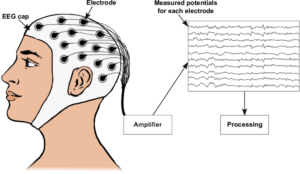EEG-Electroencephalogram: Electroencephalography is an electrophysiological monitoring method. It is used to record the electrical activity on the scalp. It shows macroscopic activity on the surface layer of the brain. Brain cells communicate through electrical impulses, which means EEG can check for any problem in the brain related to electrical impulses.
How it works
This device is designed to track and record your brain wave patterns. Flat metal discs referred to as electrodes are placed on your scalp. These electrodes are connected to wires. That relay the signals ad impulses from the electrodes to a computer that records results. These results are usually recorded in the form of
wavy lines with peaks and valleys analyzed by doctors to check If there is any abnormality in the patterns. Any irregular reading could be a result of a brain disorder or seizure.

Here are a few things you need to know about an EEG (Electroencephalogram).
They are used as a diagnostic tool for neurological symptoms
Doctors can only recommend an EEG to find the root cause of neurological symptoms. Such as seizures, fainting spells, dizziness, sensory changes, frequent headaches, memory loss, and even movement problems. However, this process has since been used by medical professionals to diagnose. It helps them to keep tabs on conditions such as epilepsy, dementia, brain injury, brain tumors, and sleep disorders.
These test results are studied by Neurosurgeons and neurologists
Your normal physician cannot order an EGG test. However, neurologists and neurosurgeons are tasked with diagnosing and treating brain and nervous system-related diseases. This gives them the authority to order these tests. In most cases, a certified neurophysiological technologist performs the test. Then presents the test results to a neurosurgeon or neurologist who can evaluate and interpret the results.
These tests are painless but take time
Most of these tests are conducted in a specialized medical facility. However, they can also be conducted in an exam room next to your physician’s office or a hospital ward. The technologist then attaches the electrodes to your scalp using washable glue. However, with the development of technologies, Companies like ZETO have developed new EEG Electroencephalogram test devices. Such as the dry eeg headset that you wear on your head. This entire test is painless. All you have to do is stay still when you lie down to ensure you get accurate results.
The procedure of the Electroencephalogram test
During the tests, they can ask you to breathe in a certain way. They can ask you to look at flashing lights and open and close your eyes. Sleeping disorder patients may have to sleep to get this test done. The average time to take this test is 2 hours.
An EEG has a low risk of complications
Some people may fear these tests siting fears of complications. However, these tests are painless, safe with very low risks of complication. Keep in mind that in seizures, the doctor may need to stimulate and record seizures to understand better what they are dealing with. Triggering the seizure will give them information on the activities of the seizure.
Read Also : The Clear and Detailed Pictures of Abdominal MRI in Santa Fe
Staff who perform the Electroencephalogram test
The attending staff will be on standby to take all the medical precautions to ensure you are safe all through the EEG-Electroencephalogram. If you have any concerns, it is best to talk to your doctor about any underlying medical conditions and any concerns you may have. To reduce the chance of contamination during the tests, you can ask about the ZETO instant EEG that employs single-use electrodes to reduce any risk of contamination.
An EEG has little to no downtime
This process involves very little to no downtime. The technologist only has to remove the electrodes from your scalp and wipe off the glue. For those with long hair, you may have to wash your hair once you get home. In case of any skin irritation, consult with your doctor. Make sure you were accompanied for the test to get a ride home.
You need know that EEG (Electroencephalogram) tests usually combine with other tests to develop conclusive results In some cases, the doctor may need to draw some blood or spinal fluid to check for genetic conditions, infections, or the presence of toxins in your blood. You can as well be subjected to tests such as a CT scan, MRI, or X-ray.
Relevant Article : A Comparison of Top EHR Solutions — Acumen vs AdvancedMD





